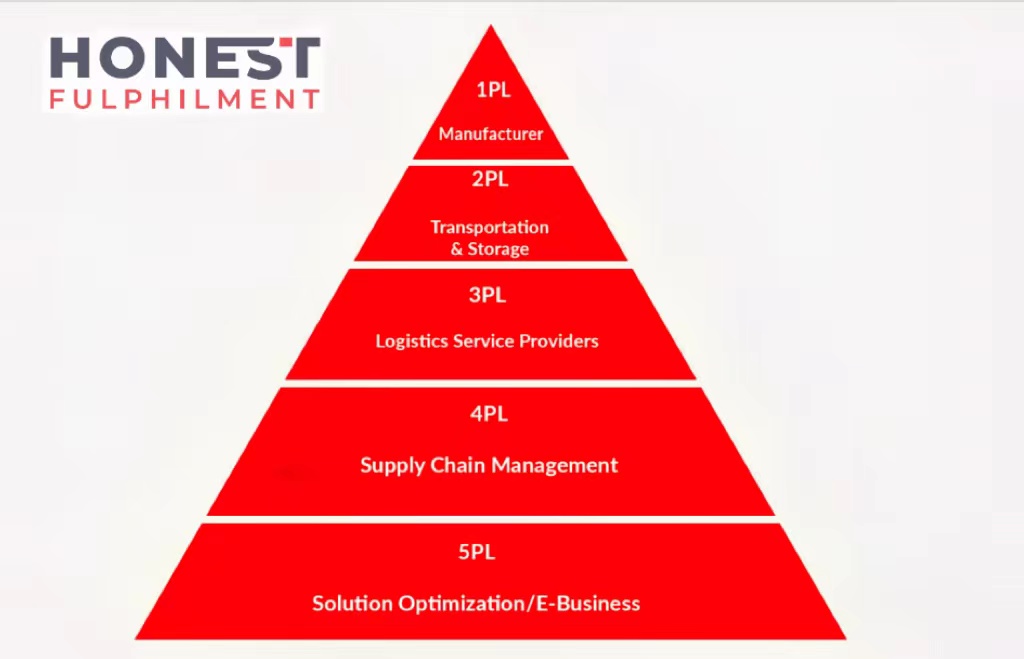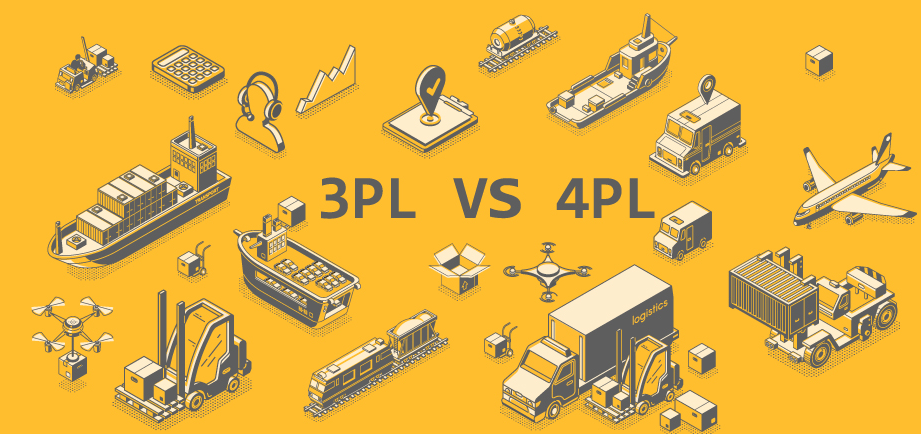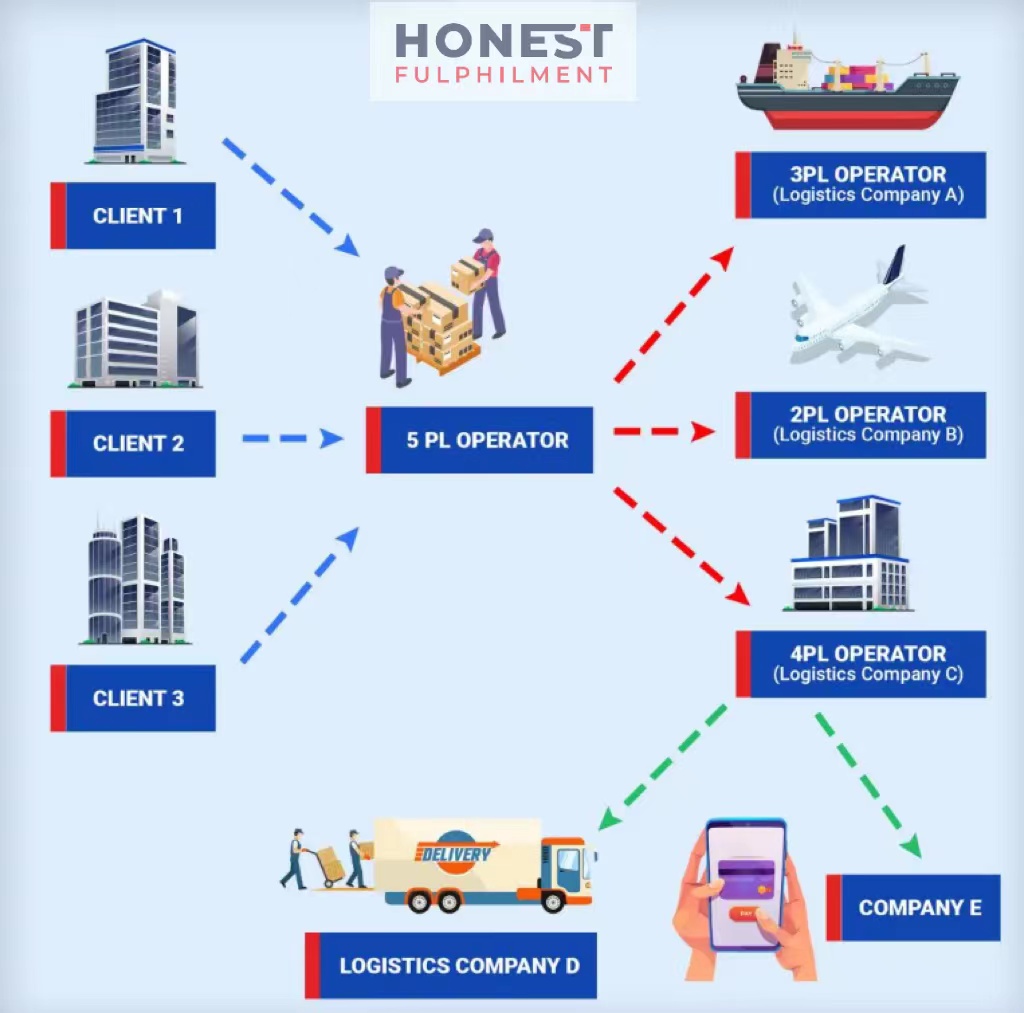What is the difference between 3PL 4PL and 5PL
- 31/08/2022
- HonestFulphilment
A 3PL is there simply to fulfill the shipper’s order. A 4PL is there to fulfill the order, to find and improve. And then a 5PL is there to handle every aspect of the supply chain. Whichever level of logistics provider you intend to use, it is necessary to have a company that you trust.

What is the difference between 1PL, 2PL, 3PL, 4PL, and 5PL logistics
What does 1pl 2pl 3pl 4pl 5pl mean?
The system 1PL 2PL 3PL 4pl 5PL refers to the classification of logistics providers. The categories explain the level of involvement of the professionals in dealing with the requirements of the customer. It helps to better identify the type of offer being made to ensure that the solution being proposed is adequately valid.
A major difference between 1PL, 2PL, 3PL, 4PL, and 5PL consists of the services offered to the company. Therefore, logistics providers are able to take care of the storage of goods and the distribution of goods, without forgetting the management of raw materials. Businesses related to transport are also an integral part of the services demonstrated by certain specialists. This concerns the subscription to insurance policies, the selection of which means of transport to use, and the framework of administrative responsibilities.
Depending on their classification as 1PL, 2PL, 3PL, 4PL, or 5PL, logistics providers also can propose integration solutions. ERP software, localized equipment for fleets or shipments, inventory management, etc. The logistics provider relies on a number of tools to supply the client company or its representatives with relevant and adaptable advice in specific situations.
The 5 main differences between 1PL 2PL 3PL 4pl 5PL

As mentioned earlier, the difference between 1pl, 2pl, 3pl, 4pl, and 5pl providers lies in their services, depending on the level of demand for them by the company.
2PL vs 3PL
2PL is when you outsource the delivery and storage of your products to an external company, so if you were dropshipping products from China, a 2PL service would ensure that your items are stored and delivered to the right place.
3PL (third party logistics) includes the storage and shipping element of 2PL, but with the addition of inventory management services, kitting and assembly, packaging, marketing and more.
There are many terms and jargon involved in the shipping process that fulfillment companies can overcomplicate you with. Freight and logistics are extremely complicated areas of your eCommerce operations, however Honest Fulfillment are here to simplify the process for you. We understand that you want to get your goods from one place to another, without a lecture in delivery process.
Difference between 4PL and 5PL
A 4PL is there to fulfill orders, find, and make improvements. Then, a 5PL is there to handle each and every aspect of the supply chain.
A 4PL provides full visibility and offers total responsibility for the supply chain to the customer. A 5PL is one such thing, but it is simply a 4PL that manages multiple customers through multiple solutions and technologies.
2PL vs 3PL vs 4PL
2PL
A 2PL owns transport assets and contracts with a company to transport its goods from one location to another. 2PLs are not involved in a company’s logistics chain. For instance, a 2PL might transport shoes from a factory to a sales shop by truck. The main logistics companies that transport goods across international borders by air, rail, or ship, such as FedEx or Maersk, are considered to be 2PLs.
Pros of 2PLs include the following:
Cons of 2PLs include the following:
3PL
3PLs generally offer a wide range of logistics services including picking, packing, shipping, short term warehousing, inventory management, labelling and handling returns. This enables many of the companies they work with to outsource much of their logistics needs to 3PLs. 3PLs serve as partners to the businesses they serve and build long-term relationships. 3PLs can also deal with some of the important customer service functions of a business, particularly around returns.
Pros of 3PLs include the following:
Cons of 3PLs include the following:
4PL
A 4PL, also known as a leading logistics partner (LLP), manages the entire logistics needs of a company, including its relationship with its 2PL and 3PL partners. They monitor the entire logistics chain and take steps to optimise it using the real-time data they are constantly collecting. A number of 4PLs do not have their own transport assets in order to maintain their neutrality in determining the best transport strategy for their customers. Nevertheless, some may have their own shipping assets that they use to contribute to the company’s logistics capabilities.
Pros of 4PLs include the following:
Cons of 3PLs include the following:
What is 4PL
4PLs, or fourth-party logistics providers, are still a relatively new model by industry standards.
A 4PL represents the manager of a 3PL network.
An independent, non-asset-based integrator, the 4PL acts as the customer’s primary point of contact, determining and pooling resources and technologies from its own organization as well as from other 3PLs to comprehensively run the customer’s supply chain.
Pros of 4PL
- Outsourcing the entire logistics chain of your business
- Taking advantage of strategic consultancy in addition to operational support
Cons of 4PL
- Little control over logistics and fulfillment processes
- Can be expensive
Difference between 3PL and 4PL with example
The major difference between a 3PL and a 4PL is that a 4PL tackles the entire supply chain, whereas a 3PL deals mainly with the logistics process. These differences between 3PL and 4PL are the subject of intense debate between these companies as to which model is superior. Ultimately, each model is better suited to different situations, and understanding the differences between them is crucial for each company.

Some of the key differences between 3PL and 4PL include:
3PL and 4PL examples
3PL examples are courier, express and parcel services; ocean carriers, freight forwarders and transshipment providers. The most significant difference between a second party logistics provider and a third-party logistics provider is the fact that a 3PL provider is always integrated into the customer’s system.
4PL examples include Shopify Fulfillment Network, Deliverr and ShipHero. there are advantages and disadvantages to working with a 4PL.
5PL examples
5PL is also known as a logistics aggregator, which aggregates customers’ needs into bulk shipments in order to obtain better prices with different operators such as airlines and shipping companies. This is true for other logistics services, such as warehousing and distribution.
Apart from the integration, management and control of the supply chain, 5PL companies also offer additional services such as call centres, online payments and courier networks.

An example shown above illustrates how 3 customers contact a 5PL operator to ship their goods to different destinations abroad. The 5PL operator integrates similar aspects of the 3 customers’ orders, i.e. sea freight, air freight and an online payment system.
Then it contracts with logistics companies A, B and C for bulk orders. Provided their delivery orders are fulfilled, these 3 customers do not need to know about these contracts.
The 5PL operator works to coordinate the entire process of delivering the goods by communicating intimately with its contracted logistics companies, whether they are 1PL, 2PL, 3PL or 4PL. In this case, it contracts with logistics company A for the sea portion of the contract and with logistics company B for the air portion of the contract. In order to complete the e-commerce end of the supply chain, it contracts with a 4PL operator. Then logistics company C works with logistics company D to handle express delivery for B2C. Company C also works with company E (an IT company) to create and manage a digital platform for B2C e-commerce transactions.
If you require a 3PL partner for your business, as well as other eCommerce fulfilment services, get in touch with our team today.
Need a Quick Quote?
– Competitive price
– Quote within 24 hours
– 30+ Shipping methods
– Dedicated account manager
– Shopify/Woo integrations
– Autofulfil
– Auto tracking
– Plus much, much more

5 Best Wholesale Home Decor Suppliers 2023



10 Best Bikini Brands For Summer 2023








